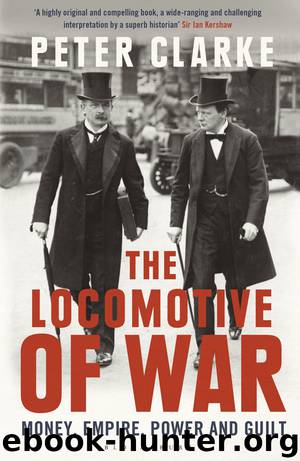The Locomotive of War by Peter Clarke

Author:Peter Clarke
Language: eng
Format: epub
Publisher: Bloomsbury Publishing
FOURTEEN POINTS OF VIEW
Part Two
WAR AND PEACE
9
Agenda for the Hall of Mirrors: Clemenceau, Lloyd George, Wilson
There was to be no ‘peace without victory’ in 1917. And there was to be no victory either, even though the French and British were now reinforced by American support. Not until November 1918 was an Armistice negotiated. Though it was a moment that had been long in coming, it came quickly in the end and was invested with conflicting expectations.
The peace treaty with Germany was eventually signed on 28 June 1919 in the magnificent palace that Louis XIV had built at Versailles. The building contained both a salon de la guerre and a salon de la paix, though whether war led to peace or peace to war was a matter of opinion. The palace’s dazzling central feature was the galerie des glaces, the Hall of Mirrors, with its seventeen mirror-clad arches, each with twenty-one mirrors serving to reflect the views of the outside world – with some distortion – through seventeen long windows. In 1871, to France’s humiliation, this was where the victorious Bismarck had declared Wilhelm I German Emperor; and in 1919 the Hall of Mirrors was again pointedly chosen, this time by Clemenceau, Père la Victoire. In a well-known painting by Sir William Orpen, Clemenceau, in the chair, turns with some animation towards Lloyd George, on his left, thus momentarily ignoring, on his right hand, President Wilson, whose steely gaze seems fixed on some more distant object. These were indeed the three men who were finally to be responsible for the Treaty: made responsible for it by their compatriots, held responsible for it by posterity.
Everyone who was anyone seemed to be in Paris in January 1919 when proceedings began. Franklin and Eleanor Roosevelt, determined to save their marriage, were already established at the Ritz when the President arrived from London, and they were to sail back to the United States in his company the next month. FDR had been in Europe the previous summer and had been distinctly more impressed by Lloyd George than by the latter’s abrasive cabinet colleague, Winston Churchill, now restored to cabinet office as Minister of Munitions. Churchill was thus again seeing plenty of Lloyd George, his boss. And Churchill had already met Woodrow Wilson in London, both at 10 Downing Street and at a glittering reception held at Buckingham Palace (where the President had taken some satisfaction in slyly rebuking him over British naval pretensions). One session of the peace conference was to bring the two men into further conflict, when Wilson openly scorned Churchill’s proposals for Allied intervention against the Bolsheviks.
The official agenda for the peace conference was settled amicably enough. Behind it lay the real agenda, which was different when looked at through French eyes, or British eyes or, still more, through American eyes: in each case for the obvious reason that it reflected a different experience of war in the preceding years. To understand this we need to take a retrospective view on what shaped the real agenda for Clemenceau, Lloyd George and Wilson.
Download
This site does not store any files on its server. We only index and link to content provided by other sites. Please contact the content providers to delete copyright contents if any and email us, we'll remove relevant links or contents immediately.
International Integration of the Brazilian Economy by Elias C. Grivoyannis(90812)
The Radium Girls by Kate Moore(11921)
Turbulence by E. J. Noyes(7935)
Nudge - Improving Decisions about Health, Wealth, and Happiness by Thaler Sunstein(7615)
The Black Swan by Nassim Nicholas Taleb(7010)
Rich Dad Poor Dad by Robert T. Kiyosaki(6399)
Pioneering Portfolio Management by David F. Swensen(6226)
Man-made Catastrophes and Risk Information Concealment by Dmitry Chernov & Didier Sornette(5921)
Zero to One by Peter Thiel(5685)
Secrecy World by Jake Bernstein(4643)
Millionaire: The Philanderer, Gambler, and Duelist Who Invented Modern Finance by Janet Gleeson(4374)
The Age of Surveillance Capitalism by Shoshana Zuboff(4209)
Skin in the Game by Nassim Nicholas Taleb(4161)
Bullshit Jobs by David Graeber(4094)
The Money Culture by Michael Lewis(4076)
Skin in the Game: Hidden Asymmetries in Daily Life by Nassim Nicholas Taleb(3929)
The Dhandho Investor by Mohnish Pabrai(3698)
The Wisdom of Finance by Mihir Desai(3650)
Blockchain Basics by Daniel Drescher(3506)
